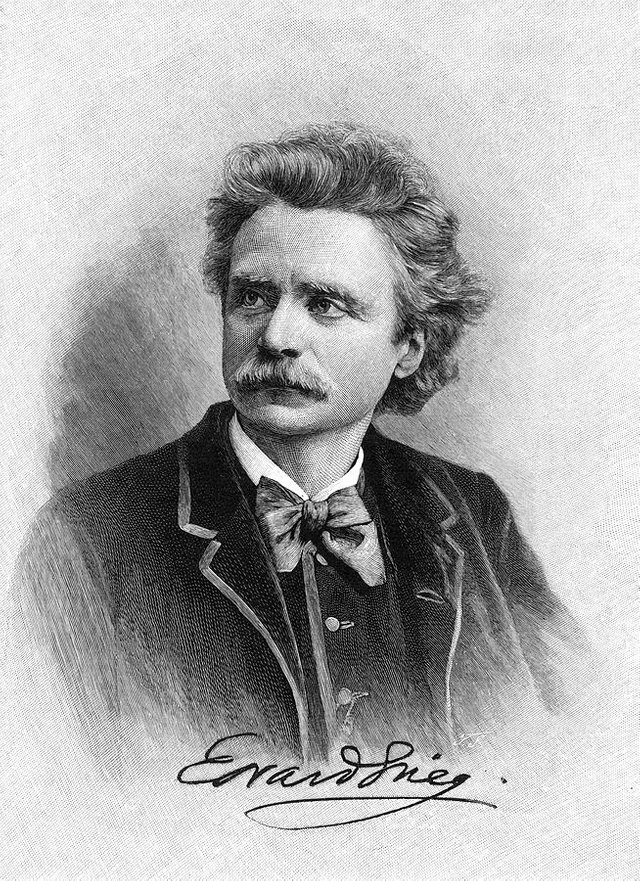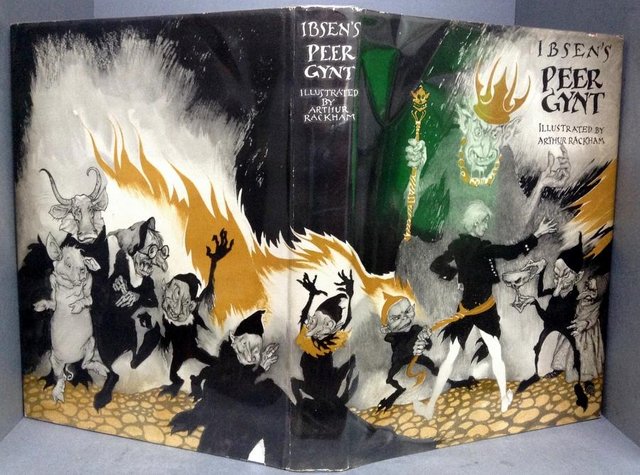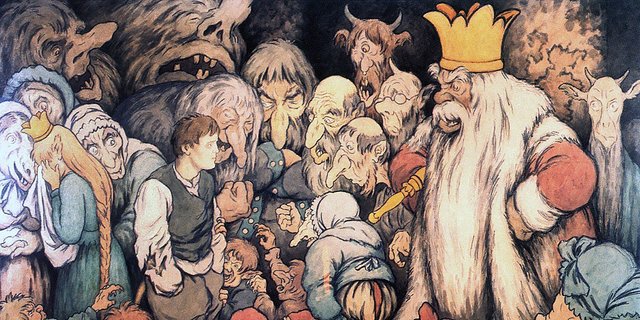Edvard Grieg - Peer Gynt (1875)
The second half of the XIX century gave little Norway suddenly several world values in art. This is the artist Edvard Munch, one of the first expressionists in principle; a wonderful writer, the forerunner of European modernism Knut Hamsun, his fellow writer Henrik Ibsen and composer Edvard Grieg.
Edvard Grieg was an interesting enough person. One must have the abyss of natural talent to become a world celebrity in the musical province against the background of brilliant colleagues who have a school based on the entire musical tradition of Southern and Central Europe.

But Grieg was very lucky. As the son of wealthy parents, he went to improve his innate skills (he started playing piano at four) at the Leipzig Conservatory, which had recently been founded by another nugget Felix Mendelssohn.
The secret of Edvard Grieg’s music, in my opinion, lies in the fact that, first of all, his talent avoided the influence of the established canonical European classical school to the maximum. Secondly, in the mid-60s of the XIX century, he experienced some insight, which led him to draw inspiration from the Norwegian folk art.
“I suddenly grasped the full depth, full width and power of those distant prospects, which had to that concept; only then I realized the greatness of the Norwegian folk art and my own calling and nature.”

Folk art, it actually has no nationality. For many centuries, only the best samples have percolated through the many thousands of people’s sieves. From here, probably, comes the intolerable simplicity of Grieg's melodies, which constantly cling to my soul. Edvard Grieg is a melodic genius, and his great merit, moreover, is that, based on folk art, he shaped it in the traditions of classical music.
Can appreciate his melodic and compositional talents on the example of his two-part suite "Peer Gynt" (1875), the melodies of which, I think, are familiar to everyone without exception.
One of them can't still be left alone by rock musicians. Let's open the suite with a stunningly fresh upbeat "Morning Mood".
Amazingly light piece with a simple and beautiful melody. I noticed that now it's performed at a faster pace than years ago. Perhaps this is the call of the times. I'll note the masterful possession of Grieg crescendo in the climaxes of these short suites, the music rolls in waves, causing inexpressible emotions.
After the bright and optimistic play "Morning", the second part of the suite, "Death of Ase", comes. One of the most dramatic works of world classical music, along with Mozart's "Requiem".
An unusually simple melodic pattern, and how extensively presented. The musical image is laconic, the play is short - only forty-five bars, but it sounds very deep. Refrain, performed in different sounds, fascinates.
"Anitra's Dance". In the story, Anitra is the daughter of a Bedouin leader who Peer Gynt is trying to steal during his travels. It is interesting how one hundred percent Northerner Edward Grieg imagined Oriental motifs - and for this he used all sorts of musical decorations. Sounds triangle and violin pizzicato, which emphasizes the elegance of the girl. Trills, forts and dynamic nuances are used, creating an intricate melody with a fairly simple rhythm.
“I Dovregubbens Hall”. This composition was loved by the rock performers for its undoubtedly remarkable structure and power. First, by the way, this saw The Who and recorded a bonus track for their album "The Who Sells Out" in 1967, then there were ELO (1973), Rick Wakeman (1974), Rainbow (1995), Apocalyptica (1999).
The melody is almost primitive, but, again, presented brilliantly. In fact, music experts say that the melody is borrowed from the national Scottish song, directly quoted. The composition itself is built on the principle of a bolero - starting quite quietly, barely audible, the melody in the lower register of bass and bassoon gradually grows until it is performed by the whole orchestra.
With this, the power of the sound grows, towards the end the melody actually turns into a march that sounds extremely powerful. Simultaneously with the power of sound, the tempo will increase. The piece is completely uncharacteristic of classical music by Grieg’s contemporaries.

It should dwell on the history of the creation of "Peer Gynt". In general, this is a play that was written by Henrik Ibsen in 1867. Scary piece in the style of Hoffmann. It is inhabited as folk characters - ugly and evil, and ordinary peasants - to match the mythological characters. The play is built around the wanderings of the protagonist Peer Gynt from his native Norway to the Sahara, America and Egypt, until he finds peace again in Norway. Among the characters in the play are trolls, witches, gnomes, kobolds.
In Scandinavia, the play was accepted quite negatively. However, Ibsen did not leave hopes for her subsequent productions, for he saw in his play something more than contemporaries. And he appealed to Edvard Grieg with a request to make music, to which he, being a great admirer of Ibsen, immediately agreed. After the deafening success of the suite, the play found rethinking and rebirth.

Henrik Ibsen was so impressed with the music of the composer, which he ordered for his play, that he decided to make Edvard a co-author and split the entire fee in half.
Initially, the suite had 28 parts, but only eight came to us, the rest were considered lost until the eighties, when they were suddenly found. I am surprised all the time by some kind of lightheadedness towards the great classical composers.
On this musical note, I finish my post. Thanks for staying until the very end. Don't forget to upvote!;)
Read my other post about Modest Mussorgsky. Pictures at an Exhibition (1874)
Resteemed, your post will appear in the next curation with a SBD share for you!
Your post has been supported and upvoted from the Classical Music community on Steemit as it appears to be of interest to our community. We also support jazz and folk music posts!
If you enjoy our support of the #classical-music community, please consider a small upvote to help grow the support account!
You can find details about us below.
The classical music community at #classical-music and Discord. Follow our community accounts @classical-music and @classical-radio or follow our curation trail (classical-radio) at SteemAuto!
Delegation links: 10SP, 25SP, 50SP, 75SP, 100SP, 150SP, 200SP, 250SP, 500SP, 1000SP
Thank you!:)
Thank you nesmeliy! You've just received an upvote of 35% by artturtle!
Learn how I will upvote each and every one of your posts
Please come visit me to see my daily report detailing my current upvote power and how much I'm currently upvoting.
Help Support Artopium & ArtoLabs
I'm asking all my friends and supporters to consider downloading the new Brave Browser as way of helping me to raise capital for Artopium & ArtoLabs. This costs you absolutely nothing, but I get a referral reward if you use Brave. If you've enjoyed using @ArtTurtle please consider doing this. I wrote this very comprehensive article about this here:
https://steemit.com/brave/@artopium/support-artopium-using-brave-browser
Hi nesmeliy,
Visit curiesteem.com or join the Curie Discord community to learn more.
@curie, thanks for the support!
This post blew my mind, it is from an analysis standpoint very thorough and thoughtful, you delved into every detail and anecdote of the history of Grieg and his creation, plus it is such a wonderful journey through the music of this gifted musician, thanks a lot for sharing!
This post was nominated by a @curie curator to be featured in an upcoming Author Showcase that will be posted in about 12 to 24 hours on the @curie blog.
NOTE: If you would like us to NOT feature your post in the Author Showcase please reply, or DM me on Discord as soon as possible. Any photos or quoted text from your post that we feature will be properly attributed to you as the author.
You can check out our previous Author Showcase to get an idea of what we are doing with these posts.
Thanks for your time and for creating great content.
Franz (@curie curator)
I'm glad you notice my posts! It is pride when someone from the @curie curators visits my blog. It's great to get into Author Showcase. Thanks!
What is the story, is not it? These people in an incredible way of thinking have left clues as you are, you never need it to be late to read and learn from time to time.
Edvard Grieg, I have to remember that name.
I was familiar with the melody of Morning mood; as you suggested, who isn't?
Fascinating story of his work and how it influeced contemporary artists and other artistic forms.
The Peer Gynt story is a great example of collaborative arts making one form even better (or at least more acceptable).
I think opening melody of "The death of Ase" must be behind the famous venezuelan singer, Jose Luis Rodriguez's hit, Atrévete (Dare)
Fatastic post.